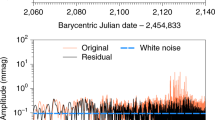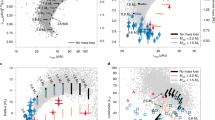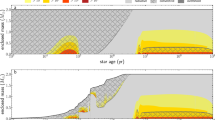Abstract
All evolved stars of up to 2 solar masses undergo a helium core flash at the end of their first stage as a giant star. Although theoretically predicted more than 50 years ago1,2, this core flash phase has yet to be observationally probed. We show here that gravity modes stochastically excited by helium-flash-driven convection are able to reach the stellar surface and induce periodic photometric variabilities in hot subdwarf stars with amplitudes of the order of a few thousandths of a magnitude. As such, they can now be detected by space-based photometry with the Transiting Exoplanet Survey Satellite in relatively bright stars (for example, Johnson–Cousins magnitudes of IC ≲ 13 mag)3. The range of predicted periods spans from a few thousand seconds to tens of thousands of seconds, depending on the details of the excitation region. In addition, we find that stochastically excited pulsations reproduce the pulsations observed in a few helium-rich hot subdwarf stars. These stars, particularly the future Transiting Exoplanet Survey Satellite target Feige 46, are the most promising candidates to probe the helium core flash for the first time.
This is a preview of subscription content, access via your institution
Access options
Access Nature and 54 other Nature Portfolio journals
Get Nature+, our best-value online-access subscription
$29.99 / 30 days
cancel any time
Subscribe to this journal
Receive 12 digital issues and online access to articles
$119.00 per year
only $9.92 per issue
Buy this article
- Purchase on Springer Link
- Instant access to full article PDF
Prices may be subject to local taxes which are calculated during checkout




Similar content being viewed by others
Data availability
The data that support the plots within this paper and other findings of this study are available from the corresponding author upon reasonable request.
Code availability
The LPCODE and LP-PUL codes used in this paper are available upon request from M.M.M.B. and A.H.C., respectively. Note that LPCODE and LP-PUL are not suitable for public distribution.
References
Schwarzschild, M. & Härm, R. Red giants of population II. II. Astrophys. J. 136, 158–165 (1962).
Thomas, H.-C. Sternentwicklung VIII. Der helium-flash bei einem stern von 1.3 sonnenmassen. Z. Astrophys. 67, 420–455 (1967).
Sullivan, P. W. et al. The Transiting Exoplanet Survey Satellite: simulations of planet detections and astrophysical false positives. Astrophys. J. 809, 77 (2015).
Kippenhahn, R., Weigert, A. & Weiss, A. Stellar Structure and Evolution (Springer, 2012).
Cassisi, S. & Salaris, M. Old Stellar Populations: How to Study the Fossil Record of Galaxy Formation (Wiley, 2013).
Chaplin, W. J. et al. Ensemble asteroseismology of solar-type stars with the NASA Kepler mission. Science 332, 213–216 (2011).
Mosser, B. et al. Red-giant seismic properties analyzed with CoRoT. Astron. Astrophys. 517, A22 (2010).
Beck, P. G. et al. Kepler detected gravity-mode period spacings in a red giant star. Science 332, 205 (2011).
Bildsten, L., Paxton, B., Moore, K. & Macias, P. J. Acoustic signatures of the helium core flash. Astrophys. J. Lett. 744, L6 (2012).
Deheuvels, S. & Belkacem, K. Seismic characterization of red giants going through the helium-core flash. Astron. Astrophys. 620, A43 (2018).
Goldreich, P. & Kumar, P. Wave generation by turbulent convection. Astrophys. J. 363, 694–704 (1990).
Shiode, J. H., Quataert, E., Cantiello, M. & Bildsten, L. The observational signatures of convectively excited gravity modes in main-sequence stars. Mon. Not. R. Astron. Soc. 430, 1736–1745 (2013).
Heber, U. Hot subluminous stars. Publ. Astron. Soc. Pac. 128, 082001 (2016).
Castellani, M. & Castellani, V. Mass loss in globular cluster red giants: an evolutionary investigation. Astrophys. J. 407, 649–656 (1993).
Brown, T. M., Sweigart, A. V., Lanz, T., Landsman, W. B. & Hubeny, I. Flash mixing on the white dwarf cooling curve: understanding hot horizontal branch anomalies in NGC 2808. Astrophys. J. 562, 368–393 (2001).
Cassisi, S., Schlattl, H., Salaris, M. & Weiss, A. First full evolutionary computation of the helium flash-induced mixing in population II stars. Astrophys. J. Lett. 582, L43–L46 (2003).
Lanz, T., Brown, T. M., Sweigart, A. V., Hubeny, I. & Landsman, W. B. Flash mixing on the white dwarf cooling curve: Far Ultraviolet Spectroscopic Explorer observations of three He-rich sdB stars. Astrophys. J. 602, 342–355 (2004).
Miller Bertolami, M. M., Althaus, L. G., Unglaub, K. & Weiss, A. Modeling He-rich subdwarfs through the hot-flasher scenario. Astron. Astrophys. 491, 253–265 (2008).
Tailo, M. et al. Rapidly rotating second-generation progenitors for the ‘blue hook’ stars of ω Centauri. Nature 523, 318–321 (2015).
Battich, T., Miller Bertolami, M. M., Córsico, A. H. & Althaus, L. G. Pulsational instabilities driven by the ϵ mechanism in hot pre-horizontal branch stars. I. The hot-flasher scenario. Astron. Astrophys. 614, A136 (2018).
Córsico, A. H., Althaus, L. G. & Miller Bertolami, M. M. New nonadiabatic pulsation computations on full PG 1159 evolutionary models: the theoretical GW Virginis instability strip revisited. Astron. Astrophys. 458, 259–267 (2006).
Lecoanet, D. & Quataert, E. Internal gravity wave excitation by turbulent convection. Mon. Not. R. Astron. Soc. 430, 2363–2376 (2013).
Couston, L.-A., Lecoanet, D., Favier, B. & Le Bars, M. The energy flux spectrum of internal waves generated by turbulent convection. J. Fluid Mech. 854, R3 (2018).
Rogers, T. M., Lin, D. N. C., McElwaine, J. N. & Lau, H. H. B. Internal gravity waves in massive stars: angular momentum transport. Astrophys. J. 772, 21 (2013).
Miller Bertolami, M. M. New models for the evolution of post-asymptotic giant branch stars and central stars of planetary nebulae. Astron. Astrophys. 588, A25 (2016).
Geier, S. et al. The catalogue of radial velocity variable hot subluminous stars from the MUCHFUSS project (corrigendum). Astron. Astrophys. 602, C2 (2017).
Naslim, N., Jeffery, C. S., Ahmad, A., Behara, N. T. & Şahìn, T. Abundance analyses of helium-rich subluminous B stars. Mon. Not. R. Astron. Soc. 409, 582–590 (2010).
Østensen, R. H. et al. KIC 1718290: a helium-rich V1093-Her-like pulsator on the blue horizontal branch. Astrophys. J. Lett. 753, L17 (2012).
Jeffery, C. S. et al. Discovery of a variable lead-rich hot subdwarf: UVO 0825+15. Mon. Not. R. Astron. Soc. 465, 3101–3124 (2017).
Latour, M., Green, E. M. & Fontaine, G. Discovery of a second pulsating intermediate helium-enriched sdOB star. Astron. Astrophys. 623, L12 (2019).
Ahmad, A. & Jeffery, C. S. Discovery of pulsation in a helium-rich subdwarf B star. Astron. Astrophys. 437, L51–L54 (2005).
Saio, H. & Jeffery, C. S. The excitation of g-mode pulsations in hot helium-rich subdwarfs. Mon. Not. R. Astron. Soc. 482, 758–761 (2019).
Gesicki, K., Zijlstra, A. A. & Miller Bertolami, M. M. The mysterious age invariance of the planetary nebula luminosity function bright cut-off. Nat. Astron. 2, 580–584 (2018).
Guerrero, M. A. et al. The inside-out planetary nebula around a born-again star. Nat. Astron. 2, 784–789 (2018).
Unno, W., Osaki, Y., Ando, H., Saio, H. & Shibahashi, H. Nonradial Oscillations of Stars (Univ. of Tokyo Press, 1989).
Vitense, E. Die wasserstoffkonvektionszone der sonne. Mit 11 textabbildungen. Z. Astrophys. 32, 135–164 (1953).
Dziembowski, W. Light and radial velocity variations in a nonradially oscillating star. Acta Astron. 27, 203–211 (1977).
Randall, S. K., Bagnulo, S., Ziegerer, E., Geier, S. & Fontaine, G. The enigmatic He-sdB pulsator LS IV-14°116: new insights from the VLT. Astron. Astrophys. 576, A65 (2015).
Dorman, B., Rood, R. T. & O’Connell, R. W. Ultraviolet radiation from evolved stellar populations. I. Models. Astrophys. J. 419, 596–614 (1993).
Acknowledgements
This work was partially supported by ANPCyT through grant PICT 2016-0053, and by the MinCyT-DAAD bilateral cooperation programme through grant DA/16/07. Funding for the Stellar Astrophysics Centre is provided by the Danish National Research Foundation (grant DNRF106). This research was supported in part by the National Science Foundation under grant NSF PHY-1748958. M.M.M.B. acknowledges the financial support by the Stellar Astrophysics Centre (Denmark) that allowed him to participate in several Aarhus red-giants challenge workshops where the central ideas of this paper were conceived.
Author information
Authors and Affiliations
Contributions
M.M.M.B. developed the idea, derived the theoretical expressions and performed the pulsation computations. T.B. derived the theoretical expressions and computed the stellar models with LPCODE. A.H.C. programmed LP-PUL and discussed the modelling of stochastic excitation. J.C.-D. provided insight into the nature of stochastic oscillations and the modelling of stochastic excitation. All authors participated in discussions of the results, their presentations in figures and descriptions in the manuscript and in pinpointing the conclusions.
Corresponding author
Ethics declarations
Competing interests
The authors declare no competing interests.
Additional information
Peer review information Nature Astronomy thanks Santi Cassisi and the other, anonymous, reviewer(s) for their contribution to the peer review of this work.
Publisher’s note Springer Nature remains neutral with regard to jurisdictional claims in published maps and institutional affiliations.
Supplementary information
Supplementary Information
Supplementary text, Figs. 1–10 and references.
Rights and permissions
About this article
Cite this article
Miller Bertolami, M.M., Battich, T., Córsico, A.H. et al. Asteroseismic signatures of the helium core flash. Nat Astron 4, 67–71 (2020). https://doi.org/10.1038/s41550-019-0890-0
Received:
Accepted:
Published:
Issue Date:
DOI: https://doi.org/10.1038/s41550-019-0890-0
This article is cited by
-
A plague of magnetic spots among the hot stars of globular clusters
Nature Astronomy (2020)



